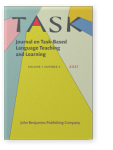Vol. 1:2 (2021) ► pp.266–288
Exploring task-based cognitive processes
Methodological advances and challenges
This paper argues that TBLT researchers should dedicate more effort to investigating the cognitive processes in which L2 learners engage during task work to facilitate theory-construction and to inform pedagogical practices. To help achieve this, a review follows of various subjective (questionnaires, interviews, think-aloud/stimulated recall protocols) and objective (dual-task methodology, keystroke-logging, eye-tracking) methods that are available to TBLT researchers to examine cognitive processes underlying task-based performance. The paper concludes that, to obtain a more valid understanding of task-generated cognitive processes, it is best to combine various methods to overcome the limitations of each. Finally, some methodological recommendations are provided for future cognitively-oriented TBLT research.
Article outline
- Introduction
- Rationale for investigating task-based processes
- Methods to investigate task-based processes
- Questionnaires
- Subjective time estimation
- Interviews
- Think-aloud protocols
- Stimulated recall protocols
- Dual-task methodology
- Keystroke-logging
- Eye-tracking
- Neuroimaging
- Triangulation of sources
- Recommendations for further research
-
References
